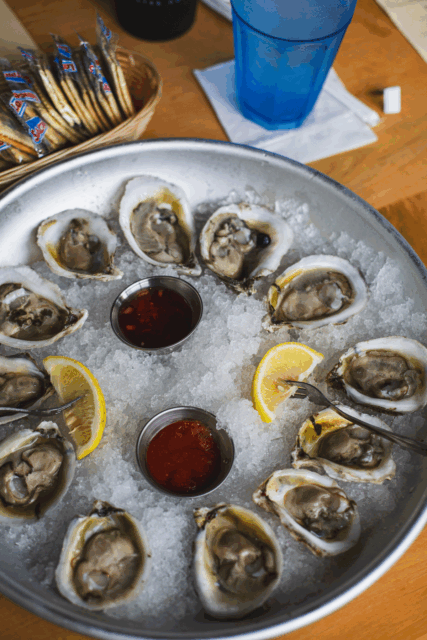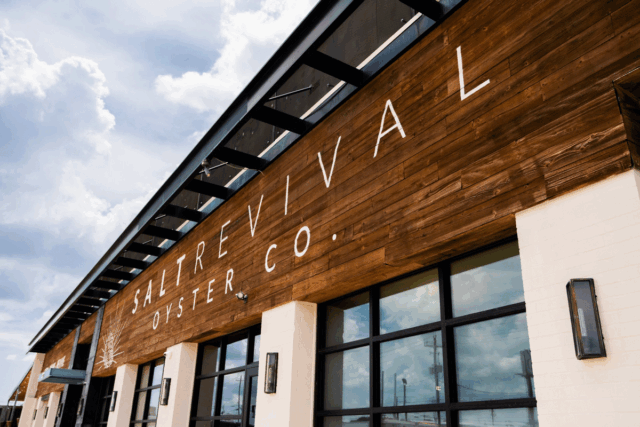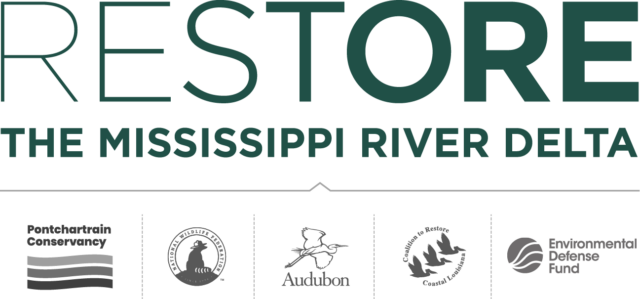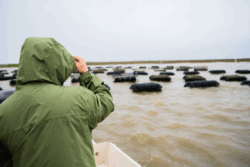Winter 2024
Bottoms Up
In Lake Charles, Salt Revival Oyster Co. seeds a new industry in neighboring Cameron Parish
Published: December 1, 2024
Last Updated: February 28, 2025

Photo by Kathryn Shea Duncan
The Cameron Alternative Oyster Culture Park.
The latest shift in the Lake Charles restaurant scene is not seismic, but it is on the rocks.
Or char-grilled or baked or fried, depending on what most whets your palate on the small but satisfying menu at Salt Revival Oyster Co. David Sorrells, former chef-owner of Restaurant Calla in Lake Charles’s Walnut Grove neighborhood and co-owner of Salt Revival Oyster Co. with Ben Herrera, is innovating in the waters of Cameron Parish through a pioneering partnership with the Cameron Parish Port, Harbor, and Terminal District (CPP).
After stepping away from Calla in 2018, Sorrells sought a way to stay in touch with the restaurant world without necessarily being in the kitchen. His research into oyster farming showed him that diversification of the industry, away from overharvesting, would have benefits echo across the ecosystem. “You bring back the oyster, you bring back the crabs, the shrimp, the fish,” Sorrells said.
Sorrells joined advocates for alternative oyster culture, or growing the oysters in floating cages off the water bottoms, in asking the Louisiana State Legislature to help seed the industry, open more waters for the method, and promote awareness. This approach to cultivating oysters does not replace the natural harvesting that Louisiana’s coast supports but provides a new facet to the industry, where natural habitats are being impacted both by natural disasters as well as Mississippi River diversion projects. Alternative oyster culture also offers a year-round revenue stream for oyster farmers whose harvests have previously been prohibited during the warmer months.

Raw oysters on the half shell from the Cameron Alternative Oyster Culture Park served at Salt Revival Oyster Co. Photo by Lucie Monk Carter
In 2022 CPP received $100,000 from Louisiana Sea Grant (LSG) to support the development of the Cameron Alternative Oyster Culture Park, a forty-eight-acre oyster farm on Calcasieu Lake. The funds came from a $3 million, three-year program LSG began in 2021.
The oysters are not plucked or tonged from reefs at the water’s bottom but grown in cages instead.
The site chosen for the park needed to suit oyster production without taking away promising spots from the area’s traditional oyster farmers. “This was depending on salinity levels, tidal flow, and a good environment for the oysters. We looked at places where reefs were growing but didn’t want to take over any of the best natural reefs in the lake or area,” said Cameron Parish Port Executive Director Kim Montie. Once established, the park was subdivided into fifteen two-acre plots that the port could lease out to potential oyster farmers.
Through this method, the oysters are not plucked or tonged from reefs at the water’s bottom but grown in cages instead. “In Calcasieu Lake,” said Montie, “you can’t dredge oysters or drag something to pick them up. You have to tong, and it’s very labor intensive. You can only harvest native oysters from November to April. After oysters spat, or have babies, they take anywhere from two to three years to grow to mature harvest size. The harvest size is three inches. You can’t harvest anything less than three inches.”
Cage-grown oysters, alternatively, can be harvested at under three inches, “whatever the market desires,” said Montie. Native oysters will grow longer, but not as deep as cage-grown; the latter’s more manageable size is favored by half-shell consumers.
In advertising to potential oyster buyers, Montie said she’s heard interest in a broader experience. “It’s turned into an ecotourism thing. People call my office and want to tour the farm, shuck the oysters, and taste them. So that’s the next step we’re working on.”

Salt Revival Oyster Co. in Lake Charles. Photo by Kathryn Shea Duncan
As for Salt Revival Oyster Co., the restaurant has been an immediate hit, with a location just down the street from McNeese State University along the busy Ryan Street corridor. Raw oysters served remain solely the product of the Cameron Alternative Oyster Culture Park, as identified on the menu, but Sorrells has engaged suppliers from Hopedale in St. Bernard Parish, to the Mississippi marsh. He hopes to keep up with demand for the other oyster preparations on the menu and not overburden the Calcasieu Lake farm in its early days.
Serving up the familiar has unexpected challenges. “When it comes to oysters, everyone has an opinion,” said Sorrells. “People are used to oysters that are six and seven years old and the size of your hand. We refer to them as cow tongues. People love those. But for the half shell, the majority of the population prefers two to two-and-a-half inches. So we’ve got a boutique, small oyster. But we’re doing it on purpose.”
Sorrells is listening closely to early reviews from locals on both the oyster size and the restaurant’s atmosphere—his favorite compliment so far is, “Man, it smells like vacation in here”—but he’s thinking more widely too as the farm and restaurant evolve. “We want to put our oysters from Cameron on the national map.”
Lucie Monk Carter is a writer and photographer in Baton Rouge.
 Restore the Mississippi River Delta is a coalition of Environmental Defense Fund, National Audubon Society, the National Wildlife Federation, Coalition to Restore Coastal Louisiana, and Pontchartrain Conservancy. Together, we are working to rebuild coastal Louisiana’s nationally-significant landscape to protect people, wildlife and jobs.
Restore the Mississippi River Delta is a coalition of Environmental Defense Fund, National Audubon Society, the National Wildlife Federation, Coalition to Restore Coastal Louisiana, and Pontchartrain Conservancy. Together, we are working to rebuild coastal Louisiana’s nationally-significant landscape to protect people, wildlife and jobs.
